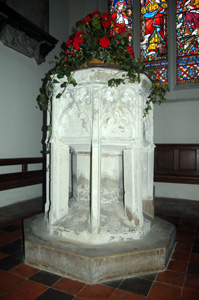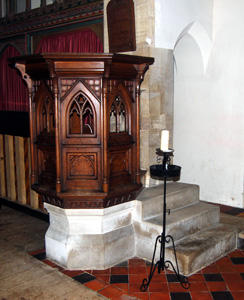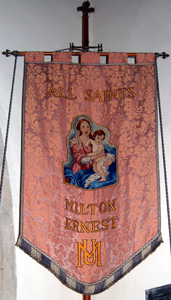List of Milton Ernest Vicars

The parish chest February 2011
Advowson
Volume III of The Victoria County History for Bedfordshire was published in 1912. It noted that the advowson was in the hands of the Albini family until Cecilia de Albini granted it to Beaulieu Priory at Beadlow, a cell of Saint Albans Abbey in the 12th century, perhaps around the time the priory was established in the 1140s. Her grandson Robert de Middleton successfully regained the advowson as he presented John de Lega in 1222. In 1275 the church was appropriated to Beaulieu once again because it was so impoverished. After Beaulieu was closed in 1434 the advowson reverted to Saint Albans Abbey.
Following the dissolution of the abbey by King Henry VIII (1509-1547) the advowson remained in the hands of the Crown though a Dr. Matthew presented in 1574 and a Mr. Dire in 1576. In 1680 the patrons were George Franklin and Mary Rolt. Edmund Turnor, Sir Justinian Isham and Edmund Turnor junior presented in 1721 and Susanna, widow of Samuel Rolt in 1723. In 1738 the patrons were Francis Jessop of Bedford, Rev. William Bedford of Yelden John Gray, of Bedford. Edmund Turnor was patron in 1775 and the Turnor family were still presenting into the 20th century.
Since 1959 the parishes of Milton Ernest and Thurleigh have shared an incumbent with Pavenham being added in 1998. The three parishes remain distinct with their own parochial church councils and church officers. The current [2014] patronage is divided between the Bishop of Saint Albans with two turns (for Milton Ernest and Thurleigh) and Lord Luke with one (for Pavenham).

The font February 2011
List of Rectors (to 1279) then Vicars of Milton Ernest
- Johannes de Lega, clerk: 1222;
- Walter Percefoil, chaplain: 1239;
- Geoffrey de Wrastlingworth [Wrestlingworth], chaplain: 1253;
- John de Wakefend;
- Thomas de Irthlingburg [Irthlingborough], clerk, admitted by the bishop on the death of John de Wakefend: 30 July 1271;
- Matthew de Bedford, chaplain: 19 September 1279;
- Robert de Conington, chaplain, on the death of Matthew: 3 December 1297;
- Fulco de Horseleya, chaplain, on the institution of Robert de Conington to Wootton Vicarage: 20 January 1302;
- Roger;
- John Roger of Lathby, priest, on the death of Roger: 9 August 1349;
- Hugh de Middleton, priest, on the resignation of John: 26 March 1350;
- John Mason;
- Roger Mapleton, chaplain, on the resignation of John Mason: 18 June 1406;
- William Fuller, priest, on the resignation of Roger Mapleton: 25 May 1409;
- Bartholomew Lovell, priest: 20 February 1447;
- John Frankellyn, priest: 10 November 1451;
- Thomas Marechall, chaplain: 10 September 1453;
- Richard Jonysson, priest, on the resignation of Thomas Marechall: 1 December 1462;
- William Gatys, priest, on the death of Richard Jonysson: 27 May 1464;
- William Conquest, vacancy: 8 November 1472;
- Richard Bagely, on the resignation of Henry Conquest: 28 July 1479;
- John Capull;
- John Abraham, on the death of John Capull: 30 October 1488;
- John Carre, priest, on the resignation of John Abraham: 8 July 1499;
- Roger Sharpe, priest, on the death of John Carre: 17 October 1500;
- William King;
- Richard Kene, chaplain, on the death of William Kyng: 8 May 1519;
- William Brasse, clerk, on the death of Richard Keene: 14 June 1539;
- Robert Thorrold, vacancy by deprivation of the last vicar; buried 7 December 1572: 8 August 1554;
- Thomas Welles, clerk, on the death of the last incumbent: 19 December 1572;
- Henry Leddisham, clerk: 22 May 1574;
- Robert Sutton, clerk, on the resignation of Henry Ledsham: 26 July 1576;
- White;
- John Smith B. A., on the death of the last incumbent; his will was proved on 31 December 1636, he wished to be buried in the chancel: 7 May 1611;
- Thomas Watson M. A.: 4 January 1636;
- John Hind, intruded: 1662;
- Thomas Leach, minister;
- John Draper B. A., ordained priest by the Bishop of Chester 15 September 1670, vacancy: 11 December 1676;
- Adam Haughton, vacancy: 23 January 1678;
- John Hawkins B. A., on the resignation of Adam Haughton; ordained priest by the Bishop of Peterborough 19 September 1680; buried 25 June 1721: 11 March 1685;
- Samuel Shepherd, on the death of Thomas Hawkins: 22 November 1721;
- Stephen Rolt A. M., on the death of Samuel Shepherd: 10 July 1723;
- George Backhouse B. A., on death of Stephen Roult: 22 March 1739;
- (Thomas Backhouse, ordained deacon to the curacy of Milton Ernest: 21 May 1749);
- William Holmes, clerk, on the death of George Backhouse: 17 August 1775;
- George Turner, clerk, on cession of William Holmes: 17 March 1783;
- Charles Turner M. A., on the death of George Turner: 11 February 1825;
- Christopher Whichcote, clerk, of the resignation of Charles Turner: 26 April 1832;
- Henry Foulis M. A., on the resignation of Christopher Whichcote: 9 May 1834;
- Charles Colyear Beaty-Pownall M.A., on cession of Henry Foulis: 1834;
- John James Burton: February 1891;
- Ernest Lewin Holmes: November 1896;
- John Thomas Ingram Bryan: December 1935;
- William Morgan: January 1946;
- Alfred Reginald Ennis: June 1949;
- John Leslie Turney: 1955;
- James Alfred Prince Daniels: 1959;
- Harold Desmond Jones: 1964;
- Andrew Peter Mottram: 1984;
- Christopher Willett Gonin: 1992;
- Victoria E. Raymer: 1998;
- Elizabeth F. Inall: 2009

The pulpit February 2011
Visitations
Volume 81 published by the Bedfordshire Historical Records Society (2002) is devoted to returns made during episcopal visitations to the county by the Bishop of Lincoln in the early 18th century, edited by former County Archivist Patricia Bell. It throws some interesting light on non-residency and the general state of the church in the parish. At this date it was common for a rector or vicar to not live in the parish he nominally served, often because he had more than one, and so employed a curate to undertake their parochial duties for him. Milton Ernest seems to have been much better served, however. The returns for Milton Ernest are as follows:
- 1706: "The value of the Vicarege [i.e. the living] is but £25 per Annum. But Sir Edmund Turner hath settled the Impropriation [the great tithes due to him as Lord of the Manor, holder of the advowson and lay rector rather than to the vicar] in the hands of Trustees upon the Church after his decease, and doth allow the greatest part thereof to the present Vicar".
- 1709: "None un-baptised come to Church; some are not confirmed. Communicants at Easter last 32. Some but seldom communicate".
- 1712: "The Vicar resides in his Vicarege House. None Un-baptized. All of age to be Confirmed will be Presented. Divine Service twice every Lord's day … Communions monthly. Out of 120 communicants between 30 and 40 receive".
- 1717: "I do Reside Personly in the Vicarage House. No Curate. None unbaptised come to Church that I know of. No Adults Baptized … Some not confirmed but intend it next time of confirmation. services Twice a Day, and twice every Lord's Day … Sacrament Monthly. Number of Communicants 90. Last Easter 27 … I give warning the Sunday before the Administration. All do not send in their Names. I have not refused it to anyone. All come to be examined before they are admitted to the Sacrament".
- 1720: "I reside personally; and in the Parsonage House. No Curate at all. Unbaptized None of our Parish. The Publick Service is duly performed twice every Lord's Day … The Sacrament of the Lord's Supper is administered once in two Months time. The Number of Communicants 56. Communicated at Easter 29".

Detail of Christ the Good Shepherd from the south aisle west window February 2011
Ecclesiastical Census
On Sunday 30th March 1851 a census of all churches, chapels and preaching-houses of every denomination was undertaken in England and Wales. The local results were published by Bedfordshire Historical Records Society in 1975 as Volume 54, edited by D. W. Bushby. The return for Milton Ernest church was made by the vicar, Charles Beaty Pownall, who noted the following pieces of information:
- The church had 120 free seats and 50 others "besides the seats for the Sunday School";
- Estimated numbers for the census day: "I did not count them"
- Average congregation in the morning was 50-60 with 60-70 Sunday scholars;
- Average congregation in the afternoon was 70-90 with 60-70 Sunday scholars.

The vexillum February 2011